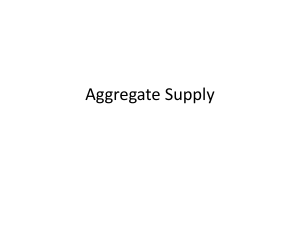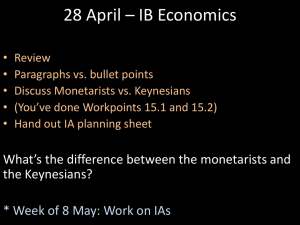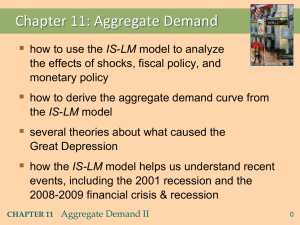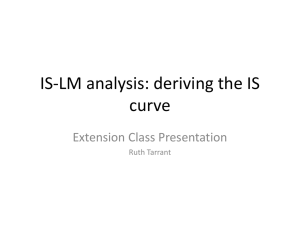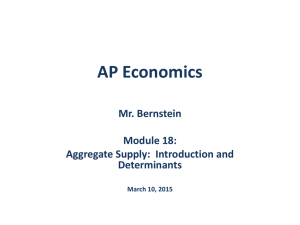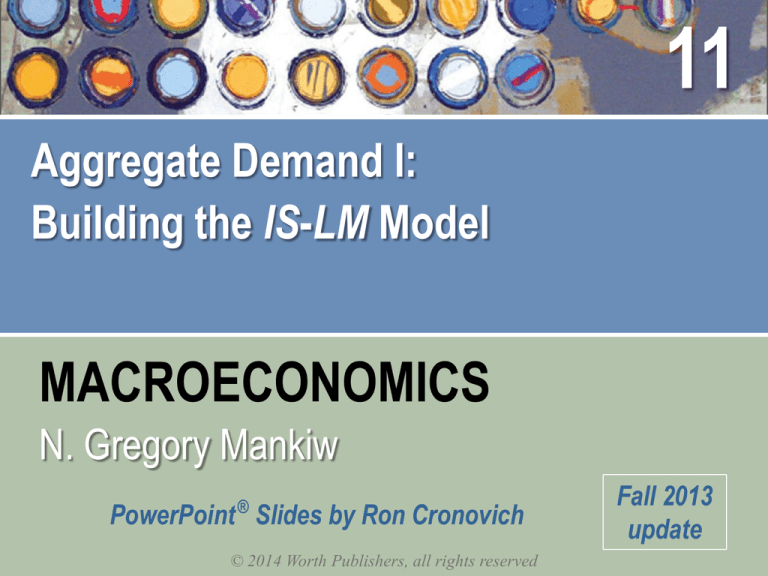
11
Aggregate Demand I:
Building the IS-LM Model
MACROECONOMICS
N. Gregory Mankiw
®
PowerPoint Slides by Ron Cronovich
© 2014 Worth Publishers, all rights reserved
Fall 2013
update
IN THIS CHAPTER, YOU WILL LEARN:
the IS curve and its relation to:
the Keynesian cross
the loanable funds model
the LM curve and its relation to:
the theory of liquidity preference
how the IS-LM model determines income and the
interest rate in the short run when P is fixed
1
Context
Chapter 10 introduced the model of aggregate
demand and aggregate supply.
Long run:
prices flexible
output determined by factors of production &
technology
unemployment equals its natural rate
Short run:
prices fixed
output determined by aggregate demand
unemployment negatively related to output
CHAPTER 11
Aggregate Demand I
2
Context
This chapter develops the IS-LM model,
the basis of the aggregate demand curve.
We focus on the short run and assume the price
level is fixed (so the SRAS curve is horizontal).
Chapters 11 and 12 focus on the closedeconomy case. Chapter 13 presents the openeconomy case.
CHAPTER 11
Aggregate Demand I
3
The Keynesian cross
A simple closed-economy model in which income
is determined by expenditure.
(due to J. M. Keynes)
Notation:
I = planned investment
PE = C + I + G = planned expenditure
Y = real GDP = actual expenditure
Difference between actual & planned expenditure
= unplanned inventory investment
CHAPTER 11
Aggregate Demand I
4
Elements of the Keynesian cross
consumption function:
C C (Y T )
govt policy variables:
G G , T T
for now, planned
investment is exogenous:
planned expenditure:
I I
PE C (Y T ) I G
equilibrium condition:
actual expenditure = planned expenditure
Y PE
CHAPTER 11
Aggregate Demand I
5
Graphing planned expenditure
PE
planned
expenditure
PE =C +I +G
MPC
1
income, output, Y
CHAPTER 11
Aggregate Demand I
6
Graphing the equilibrium condition
PE
PE =Y
planned
expenditure
45º
income, output, Y
CHAPTER 11
Aggregate Demand I
7
The equilibrium value of income
PE
PE =Y
planned
expenditure
PE =C +I +G
income, output, Y
Equilibrium
income
CHAPTER 11
Aggregate Demand I
8
An increase in government purchases
PE
At Y1,
there is now an
unplanned drop
in inventory…
PE =C +I +G2
PE =C +I +G1
G
…so firms
increase output,
and income
rises toward a
new equilibrium.
CHAPTER 11
Y
PE1 = Y1
Aggregate Demand I
Y
PE2 = Y2
9
Solving for Y
Y C I G
equilibrium condition
Y C I G
in changes
C
G
MPC Y G
Collect terms with Y
on the left side of the
equals sign:
(1 MPC)Y G
CHAPTER 11
Aggregate Demand I
because I exogenous
because C = MPC Y
Solve for Y :
1
Y
G
1 MPC
10
The government purchases multiplier
Definition: the increase in income resulting from a
$1 increase in G.
In this model, the govt
purchases multiplier equals
Y
1
G
1 MPC
Example: If MPC = 0.8, then
Y
1
5
G
1 0.8
CHAPTER 11
Aggregate Demand I
An increase in G
causes income to
increase 5 times
as much!
11
Why the multiplier is greater than 1
Initially, the increase in G causes an equal increase
in Y:
Y = G.
But Y C
further Y
further C
further Y
So the final impact on income is much bigger than
the initial G.
CHAPTER 11
Aggregate Demand I
12
An increase in taxes
PE
Initially, the tax
increase reduces
consumption and
therefore PE:
PE =C1 +I +G
PE =C2 +I +G
At Y1, there is now
an unplanned
inventory buildup…
C = MPC T
…so firms
reduce output,
and income falls
toward a new
equilibrium
CHAPTER 11
Y
PE2 = Y2
Aggregate Demand I
Y
PE1 = Y1
13
Solving for Y
Y C I G
eq’m condition in
changes
I and G exogenous
C
MPC Y T
Solving for Y :
Final result:
CHAPTER 11
(1 MPC)Y MPC T
MPC
Y
T
1 MPC
Aggregate Demand I
14
The tax multiplier
def: the change in income resulting from
a $1 increase in T :
Y
MPC
T
1 MPC
If MPC = 0.8, then the tax multiplier equals
Y
0.8
0.8
4
T
1 0.8
0.2
CHAPTER 11
Aggregate Demand I
15
NOW YOU TRY
Practice with the Keynesian cross
Use a graph of the Keynesian cross
to show the effects of an increase in planned
investment on the equilibrium level of
income/output.
16
ANSWERS
Practice with the Keynesian cross
PE
At Y1,
there is now an
unplanned drop
in inventory…
PE =C +I2 +G
PE =C +I1 +G
I
…so firms
increase output,
and income
rises toward a
new equilibrium.
Y
PE1 = Y1
Y
PE2 = Y2
17
The IS curve
def: a graph of all combinations of r and Y that
result in goods market equilibrium
i.e. actual expenditure (output)
= planned expenditure
The equation for the IS curve is:
Y C (Y T ) I (r ) G
CHAPTER 11
Aggregate Demand I
18
Deriving the IS curve
PE =Y PE =C +I (r )+G
2
PE
r
PE =C +I (r1 )+G
I
PE
Y
I
r
Y1
Y
Y2
r1
r2
IS
Y1
CHAPTER 11
Aggregate Demand I
Y2
Y
19
Fiscal Policy and the IS curve
We can use the IS-LM model to see
how fiscal policy (G and T ) affects
aggregate demand and output.
Let’s start by using the Keynesian cross
to see how fiscal policy shifts the IS curve…
CHAPTER 11
Aggregate Demand I
20
Shifting the IS curve: G
At any value of r,
G PE Y
PE =Y PE =C +I (r )+G
1
2
PE
PE =C +I (r1 )+G1
…so the IS curve
shifts to the right.
The horizontal
distance of the
IS shift equals
r
Y1
r1
1
Y
G
1 MPC
Y
Y1
CHAPTER 11
Y
Y2
Aggregate Demand I
IS1
Y2
IS2
Y
21
NOW YOU TRY
Shifting the IS curve: T
Use the diagram of the Keynesian cross or
loanable funds model to show how an increase
in taxes shifts the IS curve.
If you can, determine the size of the shift.
22
ANSWERS
Shifting the IS curve: T
At any value of r,
T C PE
PE =Y PE =C +I (r )+G
1
1
PE
PE =C2 +I (r1 )+G
…so the IS curve
shifts to the left.
The horizontal
distance of the
IS shift equals
MPC
Y
T
1 MPC
r
Y2
Y
Y1
r1
Y
Y2
IS2
Y1
IS1
Y
23
The theory of liquidity preference
Due to John Maynard Keynes.
A simple theory in which the interest rate
is determined by money supply and
money demand.
CHAPTER 11
Aggregate Demand I
24
Money supply
r
The supply of
real money
balances
is fixed:
M
interest
rate
M
P
s
P M P
s
M P
CHAPTER 11
Aggregate Demand I
M/P
real money
balances
25
Money demand
r
Demand for
real money
balances:
M
P
d
interest
rate
M
P
s
L (r )
L (r )
M P
CHAPTER 11
Aggregate Demand I
M/P
real money
balances
26
Equilibrium
The interest
rate adjusts
to equate the
supply and
demand for
money:
r
interest
rate
M
P
r1
L (r )
M P L(r )
M P
CHAPTER 11
s
Aggregate Demand I
M/P
real money
balances
27
How the Fed raises the interest rate
r
To increase r,
Fed reduces M
interest
rate
r2
r1
L (r )
M2
P
CHAPTER 11
Aggregate Demand I
M1
P
M/P
real money
balances
28
CASE STUDY:
Monetary Tightening & Interest Rates
Late 1970s: > 10%
Oct 1979: Fed Chairman Paul Volcker
announces that monetary policy
would aim to reduce inflation
Aug 1979–April 1980:
Fed reduces M/P 8.0%
Jan 1983: = 3.7%
How do you think this policy change
would affect nominal interest rates?
CHAPTER 11
Aggregate Demand I
29
Monetary Tightening & Interest Rates, cont.
The effects of a monetary tightening
on nominal interest rates
model
short run
long run
liquidity preference
Quantity theory,
Fisher effect
(Keynesian)
(Classical)
prices
sticky
flexible
prediction
i > 0
i < 0
actual
outcome
8/1979: i = 10.4%
8/1979: i = 10.4%
4/1980: i = 15.8%
1/1983: i = 8.2%
The LM curve
Now let’s put Y back into the money demand
function:
d
M
P
L (r ,Y )
The LM curve is a graph of all combinations of
r and Y that equate the supply and demand for
real money balances.
The equation for the LM curve is:
M P L(r ,Y )
CHAPTER 11
Aggregate Demand I
31
Deriving the LM curve
(a) The market for
r
real money balances
(b) The LM curve
r
LM
r2
r2
L (r , Y2 )
r1
r1
L (r , Y1 )
M1
P
CHAPTER 11
M/P
Aggregate Demand I
Y1
Y2
Y
32
How M shifts the LM curve
(a) The market for
r
real money balances
(b) The LM curve
r
LM2
LM1
r2
r2
r1
r1
L ( r , Y1 )
M2
P
CHAPTER 11
M1
P
M/P
Aggregate Demand I
Y1
Y
33
NOW YOU TRY
Shifting the LM curve
Suppose a wave of credit card fraud causes
consumers to use cash more frequently in
transactions.
Use the liquidity preference model to show how
these events shift the LM curve.
34
ANSWERS
Shifting the LM curve
(a) The market for
r
real money balances
(b) The LM curve
r
LM2
LM1
r2
r2
L (r , Y1 )
r1
L (r , Y1 )
M1
P
M/P
r1
Y1
Y
35
The short-run equilibrium
The short-run equilibrium is
the combination of r and Y
that simultaneously satisfies
the equilibrium conditions in
the goods & money markets:
Y C (Y T ) I (r ) G
r
LM
IS
Y
M P L(r ,Y )
Equilibrium
interest
rate
CHAPTER 11
Aggregate Demand I
Equilibrium
level of
income
36
The Big Picture
Keynesian
cross
Theory of
liquidity
preference
IS
curve
LM
curve
IS-LM
model
Agg.
demand
curve
Agg.
supply
curve
CHAPTER 11
Aggregate Demand I
Explanation
of short-run
fluctuations
Model of
Agg.
Demand
and Agg.
Supply
37
Preview of Chapter 12
In Chapter 12, we will
use the IS-LM model to analyze the impact of
policies and shocks.
learn how the aggregate demand curve comes
from IS-LM.
use the IS-LM and AD-AS models together to
analyze the short-run and long-run effects of
shocks.
use our models to learn about the
Great Depression.
CHAPTER 11
Aggregate Demand I
38
CHAPTER SUMMARY
1. Keynesian cross
basic model of income determination
takes fiscal policy & investment as exogenous
fiscal policy has a multiplier effect on income
2. IS curve
comes from Keynesian cross when planned
investment depends negatively on interest rate
shows all combinations of r and Y
that equate planned expenditure with
actual expenditure on goods & services
39
CHAPTER SUMMARY
3. Theory of liquidity preference
basic model of interest rate determination
takes money supply & price level as exogenous
an increase in the money supply lowers the interest
rate
4. LM curve
comes from liquidity preference theory when
money demand depends positively on income
shows all combinations of r and Y that equate
demand for real money balances with supply
40
CHAPTER SUMMARY
5. IS-LM model
Intersection of IS and LM curves shows the unique
point (Y, r ) that satisfies equilibrium in both the
goods and money markets.
41

